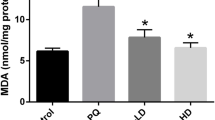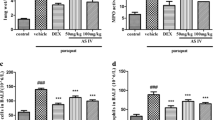Abstract
Paraquat-induced pulmonary fibrosis involves two factors, direct injury by oxygen free radicals and indirect injury by inflammatory cells and fibroblasts. Endothelin-1 (ET-1) has been shown to act as a mediator of pulmonary fibrosis, and its formation increases during oxidative stress. We investigated whether green tea extract (GTE), which has antioxidant properties, inhibits paraquat-induced pulmonary fibrosis and whether ET-1 is involved in this process. Paraquat (0.3 mg/kg) was instilled into the right lungs of rats, following which the rats were either not further treated (Group P, n = 7), or they were administered 1% GTE mixed with feed (Group PG; n = 7) or the ETA receptor antagonist ZD2574 (10 mg/kg through gavage; Group PZ; n = 7) for two weeks. As control, we used rats instilled with saline (Group N; n = 6). Two weeks after paraquat instillation, we assayed the degree of pulmonary fibrosis by light microscopic morphometry and hydroxyproline content; lipid peroxidation as a marker of oxidative stresses by measurement of malondialdehyde (MDA); ET-1 by immunohistochemistry; and prepro-ET-1 mRNA expression by reverse transcription-polymerase chain reaction. Compared with Group N, significant pulmonary fibrosis was observed in Group P, accompanied by increases in MDA, ET-1, and prepro-ET-1 mRNA expression. Compared with Group P, Group PG showed significant decreases in pulmonary fibrosis, along with decreases in MDA, ET-1, and prepro-ET-1 mRNA expression. We also observed significant decreases in pulmonary fibrosis in Group PZ compared with Group P. These findings suggest that GTE inhibits paraquat-induced pulmonary fibrosis by suppression of oxidative stress and ET-1 expression.







Similar content being viewed by others
References
Anjaneyulu M, Tirkey N, Chopra K (2003) Attenuation of cyclosporine-induced renal dysfunction by catechin: possible antioxidant mechanism. Ren Fail 25:691–707
Autor AP (1974) Reduction of paraquat toxicity by superoxide dismutase. Life Sci 14:1309–1319
Barnes PJ (1994) Endothelins and pulmonary diseases. J Appl Phsiol 77:1051–1059
Coker RK, Laurent GJ (1998) Pulmonary fibrosis: cytokines in the balance. Eur Respir J 11:1218–1221
Conte A, Pellegrini S, Tagliazucchi D (2003) Synergistic protection of PC 12 cells from beta-amyloid toxicity by resveratrol and catechin. Brain Res Bull 62:29–38
Cooper JA Jr, Zitnik RJ, Matthay RA (1988) Mechanisms of drug-induced pulmonary disease. Annu Rev Med 39:395–404
Copland GM, Kolin A, Shulman HS (1974) Fatal pulmonary intra-alveolar fibrosis after paraquat ingestion. N Engl J Med 291:290–292
Dubaybo BA, Durr RA, Thet LA (1987) Unilateral paraquat-induced lung fibrosis: evolution of changes in lung fibronectin and collagen after graded degrees of lung injury. J Toxicol Environ Health 22:439–457
Frei B, Higdon JV (2003) Antioxidant activity of tea polyphenols in vivo: evidence from animal studies. J Nutr 133:3275S–3284S
Fujiki H, Suganuma M, Okabe S, et al. (2000) A new concept of tumor promotion by tumor necrosis factor-alpha, and cancer preventive agents (−)-epigallocatechin gallate and green tea–a review. Cancer Detect Prev 24:91–99
Gauldie J, Jordana M, Cox G (1993) Cytokines and pulmonary fibrosis. Thorax 48:931–935
Giaid A, Michel RP, Stewart DJ, et al. (1993) Expression of endothelin-1 in lungs of patients with cryptogenic fibrosing alveolitis. Lancet 341:1550–1554
Greenberg DB, Lyons SA, Last JA (1978) Paraquat-induced changes in the rate of collagen synthesis by rat lung explants. J Lab Clin Med 92:1033–1042
Greenberg DB, Reiser KM, Last JA (1978) Correlation of biochemical and morphologic manifestations of acute pulmonary fibrosis in rats administered paraquat. Chest 74:421–425
Henry JP, Stephens-Larson P (1984) Reduction of chronic psychosocial hypertension in mice by decaffeinated tea. Hypertension 6:437–444
Higuchi A, Yonemitsu K, Koreeda A, Tsunenari S (2003) Inhibitory activity of epigallocatechin gallate (EGCg) in paraquat-induced microsomal lipid peroxidationr—a mechanism of protective effects of EGCg against paraquat toxicity. Toxicology 183:143–149
Hocher B, Schwarz A, Fagan KA, et al. (2000) Pulmonary fibrosis and chronic lung inflammation in ET-1 transgenic mice. Am J Respir Cell Mol Biol 23:19–26
Hsu SM, Raine L, Fanger H (1981) Use of avidin–biotin–peroxidase complex (ABC) in immunoperoxidase techniques: a comparison between ABC and unlabeled antibody (PAP) procedures. J Histochem Cytochem 29:577–580
Isemura M, Saeki K, Kimura T, et al. (2000) Tea catechins and related polyphenols as anti-cancer agents. Biofactors 13:81–85
Kaehler J, Sill B, Koester R, et al. (2002) Endothelin-1 mRNA and protein in vascular wall cells is increased by reactive oxygen species. Clin Sci 103 Suppl 48:176S–178S
Kahaleh MB (1991) Endothelin, an endothelial-dependent vasoconstrictor in scleroderma: enhanced production and profibrotic action. Arthritis Rheum 34:978–983
Kahler J, Mendel S, Weckmuller J, et al. (2000) Oxidative stress increases synthesis of big endothelin-1 by activation of the endothelin-1 promoter. J Mol Cell Cardiol 32:1429–1437
Lee JH, Chun YG, Lee IC, et al. (2001) Pathogenic role of endothelin-1 in hemodynamic dysfunction in experimental acute pulmonary thromboembolism. Am J Respir Crit Care Med 164:1282–1287
Mallat A, Fouassier L, Preaux AM, et al. (1995) Growth inhibitory properties of endothelin-1 in human hepatic myofibroblastic Ito cells: an endothelin B receptor-mediated pathway. J Clin Invest 96:42–49
Minkes RK, Bellan JA, Saroyan RM, et al. (1990) Analysis of cardiovascular and pulmonary responses to endothelin-1 and endothelin-3 in the anesthetized cat. J Pharmacol Exp Ther 253:1118–1125
Nakano J, Takizawa H, Ohtoshi T, et al. (1994) Endotoxin and proinflammatory cytokines stimulate endothelin-1 expression and release by airway epithelial cells. Clin Exp Allergy 24:330–336
Okabe S, Ochiai Y, Aida M, et al. (1999) Mechanistic aspects of green tea as a cancer preventive: effect of components on human stomach cancer cell lines. Jpn J Cancer Res 90:733–739
Park SH, Saleh D, Giaid A, Michel RP (1997) Increased endothelin-1 in bleomycin-induced pulmonary fibrosis and the effect of an endothelin receptor antagonist. Am J Respir Crit Care Med 156:600–608
Peacock AJ, Dawes KE, Shock A, et al. (1992) Endothelin-1 and endothelin-3 induce chemotaxis and replication of pulmonary artery fibroblasts. Am J Respir Cell Mol Biol 7:492–429
Sachinidis A, Seul C, Seewald S, et al. (2000) Green tea compounds inhibit tyrosine phosphorylation of PDGF beta-receptor and transformation of A172 human glioblastoma. FEBS Lett 471:51–55
Schoenberger CI, Rennard SI, Bitterman PB, et al. (1984) Paraquat-induced pulmonary fibrosis. Role of the alveolitis in modulating the development of fibrosis. Am Rev Respir Dis 129:168–173
Skillrud DM, Martin WJ 2nd (1984) Paraquat-induced injury of type II alveolar cells. An in vitro model of oxidant injury. Am Rev Respir Dis 129:995–999
Smith LL (1987) Mechanism of paraquat toxicity in lung and its relevance to treatment. Hum Toxicol 6:31–36
Smith P, Heath D, Kay JM (1974) The pathogenesis and structure of paraquat-induced pulmonary fibrosis in rats. J Pathol 114:57–67
Sueoka N, Suganuma M, Sueoka E, et al. (2001) A new function of green tea: prevention of lifestyle-related disease. Ann N Y Acad Sci 928:274–280
Williams SN, Shih H, Guenette DK, et al. (2000) Comparative studies on the effects of green tea extracts and individual tea catechins on human CYP1A gene expression. Chem Biol Interact 128:211–229
Xu FP, Chen MS, Wang YZ, et al. (2004) Leptin induces hypertrophy via endothelin-1-reactive oxygen species pathway in cultured neonatal rat cardiomyocytes. Circulation 110:1269–1275
Zhao BL, Li XJ, He RG, Cheng SJ, Xin WJ (1989) Scavenging effect of extracts of green tea and natural antioxidants on active oxygen radicals. Cell Biophys 14:175–785
Acknowledgments
This article was supported by grants 2000-119 and 2003-119 from Asan Life Science Institute. Supported by a grant of the Korean Health 21 R:D Project, Ministry of Health: welfare, Republic of Korea (0412-CR03-0704-0001).
Author information
Authors and Affiliations
Corresponding author
Additional information
Hak-Ryul Kim and Byung-Kyu Park contributed equally to this work.
Rights and permissions
About this article
Cite this article
Kim, HR., Park, BK., Oh, YM. et al. Green Tea Extract Inhibits Paraquat-Induced Pulmonary Fibrosis by Suppression of Oxidative Stress and Endothelin-l Expression. Lung 184, 287–295 (2006). https://doi.org/10.1007/s00408-005-2592-x
Accepted:
Issue Date:
DOI: https://doi.org/10.1007/s00408-005-2592-x




